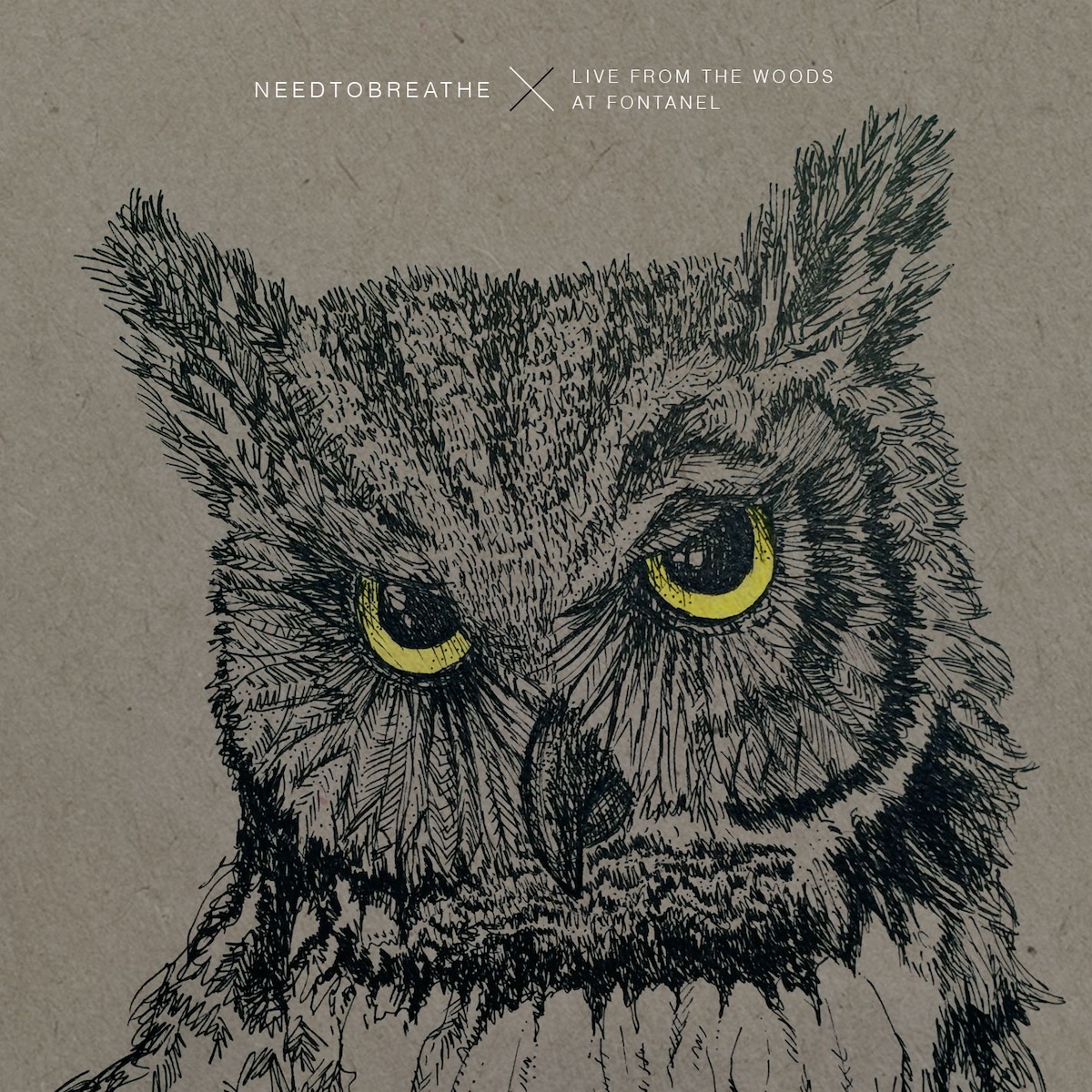Blog
Album Of The Day: Live From The Woods by Needtobreathe

I had heard for a few years about the fun live shows that Needtobreathe put on, but it wasn't until about 5 years into their existence as a major-label band that I got around to seeing them play live. And I was hooked. Their albums are good southern rock with a bit of gospel/blues thrown in in places, but only once I heard them play live did I really like them. They're all great musicians and the band can really play, plus they know how to put on a good show with the video screens, lights, etc. This 2-CD Live At The Woods album captures the audio of their live show really well and features some of the best songs of their first 5 albums. Many songs run 5 or 6 minutes long with the band jammin' and rockin' the crowd. On occasion, lead singer Bear Rinehart shares a bit about the song before they perform it, and it's meaningful and doesn't get too old on repeated listens. Needtobreathe is a really good band, and this live recording is just as good as their studio albums, in my opinion. I always enjoy when they come to town, but this album is the next best thing.
Release Year: 2015
Listen on Apple Music
Listen on Spotify
Album Of The Day: Where The Light Shines Through by Switchfoot

"Your wounds are where the light shines through." Released 9 years ago today, this is the tenth album from Switchfoot, one of my all-time favorite bands. This is definitely not my favorite album from this band, but it by no means has caught the boys napping. The band are seasoned musicians, and they each play their parts making great rock/pop music. Songs like "Holy Water", "If The House Burns Down Tonight" and "Bull In A China Shop" give guitarist Drew Shirley opportunities to show off his guitar prowess, and the title track has some beautiful blues licks mixed in with it. "Float" is a really fun pop song and is a hit at concerts, plus an excuse to turn on the bubble machine. Songs like "I Won't Let You Go", "The Day That I Found God" and "Live It Well" do have some religious language which some fans like and others do not, but they're still solid slower songs from Switchfoot. It's not their best album but it's still a first-class collection of songs from five guys who like to entertain and ask some of the deeper questions about life.
Release Year: 2016
Listen on Apple Music
Listen on Spotify
Album Of The Day: Hello Maker by Bright City

Released 8 years ago today, this is the second album from Bright City, the modern worship team from St. Peter's Church in Brighton, UK. The lyrics are much like other contemporary praise and worship with songs of to God for church services or other events. However, this album's production is a bit more of a dance-pop sound than your average worship music, and some tracks really get the BPMs up there. "Rock Of Our Salvation" and "Come Holy Spirit" are instant classics, if you ask me, and Martin Smith of delirious? sings lead vocals on the latter song and co-writes on many others. His daughter, Elle Limebear, also takes lead vocals on a few other tracks which she also re-recorded on her solo album a few years later. There's a large group of people on the Bright City worship team, though, so no one person leads the majority of the 10 tracks, and the talented musicians provide a lush, bass-filled instrumental track under the melody. It's an engaging album that keeps the music focused on God and I think it's a bit better than most of those mega-church modern worship bands. I hope they continue to make music.
Release Year: 2017
Listen on Apple Music
Listen on Spotify
Album Of The Day: The Medicine by John Mark McMillan

Released 15 years ago today on Integrity Music, this is the third John Mark McMillan album though the first album of his easily available due to it being released on a label. First released as a 10-track independent album in 2008, it was released with 4 bonus tracks including his new version of the widely popular "How He Loves". John Mark McMillan got his start in leading worship services at churches, but though albums like The Medicine it's clear that he had more aspirations to be a rock artist and not just a worship leader. Though maybe a few songs on this album could be sung for communal worship, John Mark McMillan's songwriting and performance was more poetic and nuanced than songs for church services; it's much more of a personal expression of McMillan's artistic vision. And I love this album's sound; it's a southern rock sound complete with excellent electric guitars, drums and bass along with other little touches. The lyrics definitely have a lot of religious language, but are very different than what most churches sing in praise and worship to God. This album immediately made me a John Mark McMillan fan as soon as I got a copy.
Release Year: 2010
Listen on Apple Music
Listen on Spotify

Album Of The Day: Illinois by Sufjan Stevens

Released 20 years ago today in the United States, this is the second and last of Sufjan Stevens's albums that is loosely based on a U.S. state. Known as Illinois, the full title of this album is Sufjan Stevens invites you to: Come on feel the ILLINOISE, and the titles of some of the tracks are much, much more verbose and sometimes a whole story unto themselves. At 74 minutes and 22 tracks, this is a magnum opus for the artist and a incorporates many new sounds to the musical styles of Stevens, whose music was often mostly banjo-heavy, quirky folk-rock music before this. This album has elements of marching bands, classical, electronica, musical theater, and much more with many of the instruments played in the studio by Sufjan himself. Lyrically, it makes a lot of references to Illinois history and geography, mentioning lots of city names and places as well as historical events such as the World's Columbian Exposition, John Wayne Gacy, Jr.'s actions as a serial killer, and that the fictional city of Metropolis that Superman resides in is somewhat based off Chicago. But it also uses these bits as a pushing-off point to talk about other subjects, weaving in religious themes and more universal questions of life, such as referencing Chicago's most famous skyscraper "The Sears Tower" in the track "The Seer's Tower", referencing the Apocalypse and Sufjan's relationship with God. 20 years later, it still is Sufjan Stevens's most successful album by sales and is definitely an interesting listen the whole way through due to its mini-songs and musical interludes.
Release Year: 2005
Listen on Apple Music
Listen on Spotify
Album Of The Day: Flap Your Wings by The Choir

Released on this day 25 years ago, this is the 9th studio album from alternative rock band The Choir, and the first release from this band that I was exposed to, as I bought this CD a few years later at some sort of store while music shopping. It's not music I listen to often, but "Mercy Lives Here" is very beautiful and "Hey Gene" finds the band grappling with their close friend Gene Eugene dying so unexpectedly. And though this recording of "Beautiful Scandalous Night" is maybe not as beloved as other versions on more worship-focused albums, but it's the band's own version. The lyrics of some of these rock songs also seem to be about personal joys and struggles with relationships and starting families as well. It's maybe not The Choir's most beloved album, but it's a good album and worthy of a listen, I think.
Release Year: 2000
Listen on Apple Music
Listen on Spotify
Buy on Bandcamp
Album Of The Day: Disappear by PFR

Released 24 years ago today, this is the fifth studio album from the band PFR. In 1996, the band broke up, but in 2000 they reunited for a track on the Roaring Lambs album. They decided to reunite and recorded an album, but as soon as the album was released, their label folded and the album never really got the promotion they deserved. The band may have been a bit disappointed with the sound, though I have a copy of the CD and it sounds very good to me. It's definitely not exactly the same as their '90s albums, but it's some solid rock/pop songs with some three-part harmonies and religious language. 24 years later, they are working to give fans a chance to rediscover the album. Through a crowd-funding campaign, they are getting the album remastered and will release it on CD, vinyl and streaming. So whether you have heard this album or if you have not, you can support their Kickstarter campaign to re-release the album independently, and sometime this year or next, it will be on streaming for everyone to hear.
Release Year: 2001
Crowdfund the album's re-release
Album Of The Day: Halcyon Days by Chagall Guevara

What do you expect from a band that hasn't released any music in over 30 years? Probably nothing, usually. But in this case, you will find the unexpected. Released 3 years ago today, this is the second studio album from the oddly-named band Chagall Guevara. The band's members had a successful crowd-funding campaign in 2020, and one of the excellent results was Halcyon Days, a collection of mostly new songs from this band that had not played for nearly 30 years but was mostly music industry veterans. (A few songs were written in that early '90s era, and there's an excellent Mark Heard cover to close out the album as well.) It's an eclectic collection of music, with "Still Know Your Number By Heart" having a country lilt and other songs being much more of a classic rock style. The lyrics are a bit of a puzzle, but definitely have a dry humor and do a bit of poking fun at the establishment and the music industry. It's definitely not a new band and it's a bit of a throwback sound, but it's fun to hear some new recordings from a band that has resurrected after 30 years of the members doing other things.
Release Year: 2022
Listen on Apple Music
Listen on Spotify
Album Of The Day: Crooked by Propaganda

"I don't hate America, just demand she keeps her promises." Released 8 years ago today, this is my favorite album from rapper Propaganda and one of my favorite rap albums ever. I first heard Propaganda in the LA crew Tunnel Rats back in the early 2000s, and "Slow Cook" and "Do Know Wrong" definitely incorporate some of the vibes from the underground rap that was Propaganda's start. Still, the poet and rapper known as Propaganda has done so much more than that since then, and the musical styles on this album reflects that. "Crooked Ways", "Cynical" and "Gentrify" are some of my favorites here. "It's Complicated" and "I Hate Cats" are more spoken word interludes than rap, but fit really well into the album, in my opinion. Propaganda clearly shares his worldview as a black man throughout and digging into his lyrics has definitely helped educate me on the life of black people in today's culture. I might not fully understand everything he's saying yet or the communities he comes from, but I love the sounds and his wordplay, plus the excellent music his team put together for this album. Thanks, Propaganda, for reaching out to so many communities and coming to Minneapolis and AudioFeed to perform live, and I hope we continue to get new music from you as the world spins on.
Release Year: 2017
Listen on Apple Music
Listen on Spotify
Album Of The Day: Travel III by Future Of Forestry

Released 15 years ago today, this was the third of three EPs released by Future Of Forestry on the theme of "travel", and it's one of their best releases in my opinion. The band gets going with the rockin' "Bold & Underlined", and definitely gets more electronic with "Protection". "Did You Lose Yourself?" is probably the best song on the EP, with a beautiful pop sound and strings that are a foretaste of the band's sound on their later independent releases. Eric Owyoung, the songwriter and musician who is the heart of Future Of Forestry, its a very talented writer and these Travel I, Travel II, and Travel III EPs were fun explorations of his talents and the many types of songs he can create. This EP is maybe the most rock 'n' roll the band ever gets, which is unfortunate in my opinion, but I continue to love the music put out by Future Of Forestry for almost 20 years now.
Release Year: 2010
Listen on Apple Music
Listen on Spotify